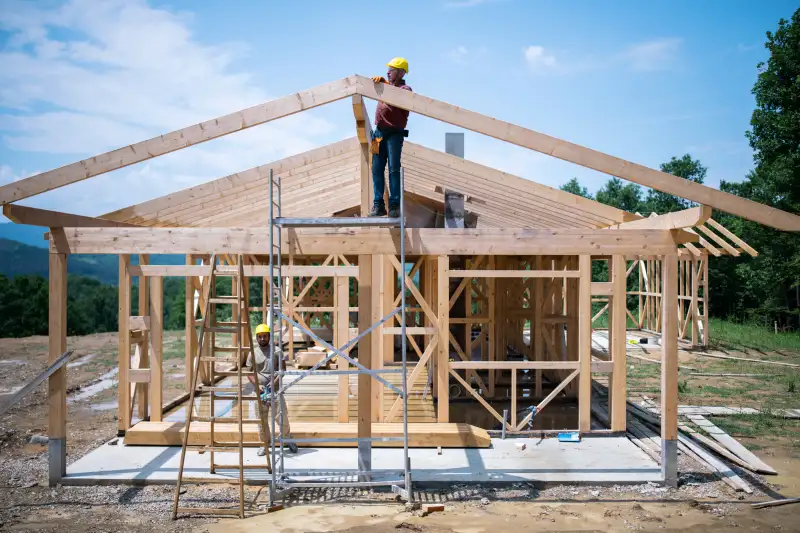How to Buy a New Construction Home: A Guide for Beginners

If the pandemic-induced housing shortage has made finding your dream home feel impossible, new construction may be an answer. Many buyers have already gone this route.
Last year, single-family home construction increased 12%, according to the National Association of Home Builders. This year looks promising as well. Through February, housing starts were 6.4% higher year-over-year and new construction homes made up 14% of all single-family sales.
As working from home continues to shape what people look for in a house this year, Robert Dietz, chief economist for NAHB, expects new construction to continue growing, though more slowly than in 2020.
But know that buying a brand new home is anything but straightforward. From home financing to home warranties, here are key questions to get started.
What’s the difference between a spec home and a custom home?
If you’re considering a new construction home, you have a few options.
Spec homes are usually located in large residential developments or subdivisions and built to the developer’s specifications. As a buyer, you would purchase the home as built and would not be able to ask for changes.
This experience would be similar to buying an existing home because spec homes are usually already built or close to complete. If you’re looking for a move-in ready home, a spec home is your best option.
Thanks to the pandemic buying frenzy spec homes are hard to find. Alec Hartman, CEO and co-founder of Welcome Homes, an online residential builder, notes that there’s typically a year’s supply of spec-built homes available. This year, they’re almost all sold out. That leaves semi-custom and custom-built homes for new construction buyers.
Like a spec-home, semi-custom homes are usually found in large developments and built to developer specifications, but you get some options. Semi-custom buyers can choose between different floor plans and interior finishes, for example. Some developers will allow additional customization for an added cost.
If you’re looking for some control but don’t necessarily want to start from scratch, a semi-custom build is a good choice. Spec and semi-custom homes make up 75% of all new single-family construction.
Custom homes are built entirely to buyer specifications and make up 20% of new construction. (The remaining 5% is built-to-rent.) It’s built on land you already own or buy, and you would independently hire an architect and a builder to turn your vision into reality.
A custom build gives you full control, but also means managing a lot of details and making hundreds of little decisions.
How much does a new home cost?
In February, the median price of a newly built single-family home was $349,400, according to the U.S. Census Bureau, while the median home price for an existing home increased to $313,000 as per data from NAR.
According to NAHB’s 2020 Cost of Constructing a Home report, the average construction cost of a new single-family home is $296,652 not counting the cost of land) or about $114 per square foot.
Keep in mind that with the cost of materials rising, building costs can increase even once you’ve started construction.
In February housing starts slowed, as a trifecta of higher materials cost, increasing interest rates and severe winter weather caused builders to hit the pause button. The cost of lumber alone has increased 199% since April of 2020, adding an average of $24,000 to the cost of a newly built home, says Dietz.
Hartman recommends that you get a Guaranteed Maximum Price contract, which can help keep control of your budget. This type of contract means the contractor is paid for actual costs incurred, plus a fee, up to a maximum price. Any cost overruns are paid by the contractor unless the owner has approved additional change orders.
Costs will vary by region, with higher costs in urban areas than suburban or rural areas. It’s also easy to get carried away by upgrades that can significantly add to the price of the home. Pay particular attention to costs that may not be immediately obvious, such as landscaping or personal decorating touches. While these are not included in the cost of a build, they should be part of your budget.
What are the financing options for a newly built home?
If you’re buying a spec or semi-custom built home in a large development, you're going to need what is called a new construction loan.
In this case, you generally apply for a mortgage before the home is built and present the builder with a loan pre-approval in order to guarantee the purchase. The loan closes once the home is ready for move-in.
If you’re doing a custom build, you’ll need a construction loan. In this case, the mortgage works as a line of credit, allowing disbursements from the approved amount as the build progresses. During this time, you’ll make interest-only payments. Once the build is done, the loan will be converted into a regular mortgage.
If you are buying in a new development, the developer may recommend a lender that is familiar with the project. This can be convenient, but you don’t have to use that lender. You can and should shop around to see which lender will offer you the best mortgage rate and terms.
How long does it take to build a home?
A fully custom-built home can take a year or more to complete. On average, the wait for a spec home or semi-custom home is six-to-seven months, barring weather delays, a shortage of materials or other setbacks.
Delays are common, so whichever option you choose, make sure your current living arrangements are flexible. If you’re renting, talk to your landlord about potentially extending your lease month-to-month.
If you need to sell the home you’re living in, you may want to hold off putting it on the market until the build is nearly complete or add a leaseback clause to the sale contract allowing you to stay in your home a while longer.
How do I know I am hiring a reputable builder?
Whether it be a spec, semi-custom, or custom-built home, you want to ensure you’re using a quality builder. Look for online reviews and ratings from organizations like the Better Business Bureau or your local homebuilder’s association.
Ask family and friends who may have recently built a home about their experience. You can also check with local real estate agents to get information about new developments that may be under construction. Then visit the model home to check the construction quality. Pay attention to the details like cabinetry, trim work, flooring, and paint.
Take a weekend to drive through developments and subdivisions that have already been built and sold. If there are homeowners outside doing chores, stop, introduce yourself and ask whether they’re happy with their homes, if they had any quality issues during or after the build, and how the builder responded.
For a custom build, interview different builders, ask for reference from recent buyers and ask a lot of questions such as: do they offer a warranty program and what are the estimated property taxes.
Hartman recommends custom buyers hire an independent construction manager who can make weekly walkthroughs of the home to ensure it is being built according to plans as well as to code. If you’re buying an already or close to being built home, a home inspection can point out items that may not be up to code in time for the builder to make the necessary repairs. It’s easier to fix problems with the electrical or plumbing systems before walls and flooring go in.
Do I need a builder warranty?
As opposed to a home warranty, which homeowners can buy to cover appliances, a builder’s warranty covers the home’s materials and workmanship. Builder warranties are required by state laws. Most builders will provide a warranty of their own or through a third party provider at no additional cost to the buyer.
The warranty will cover items like the electrical and plumbing, heating and air conditioning systems, insulation and roofing. It won’t cover things like defects caused by another contractor or the homeowner, faded paint or weather-related damage.
According to Hartman, builder warranties are regulated by each state, so check what the minimum requirements are where you live. Average coverage runs between six months to three years, although some states, like New Jersey, require builders to provide 10 years of warranty coverage for structural defects.
Beyond the state minimums, builders can offer an extended warranty at an additional cost. Review all the warranty documents before signing them to make sure you understand what is and isn’t covered and for how long.
More from Money:
7 Best Mortgage Lenders of 2021
Rushing to Buy a Home Can Lead to Serious Regret. Here's How to Not Hate Your House
